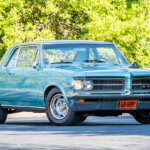
Source: Motofutura
The history of the Volkswagen Bus, fondly known as the “VW Bus” or “Microbus,” is a captivating tale of innovation, freedom, and counterculture that has left an indelible mark on the automotive world. From its humble beginnings as a post-war commercial vehicle to becoming an emblem of the 1960s counterculture movement, the VW Bus has touched the lives of countless people and earned a special place in the hearts of enthusiasts worldwide. In this article, we will embark on a journey through time to uncover the origins, design, and evolution of this iconic vehicle that continues to evoke nostalgia and wanderlust.
Ben Pon — VW T2 Sketch
In the aftermath of World War II, Europe was in dire need of affordable and reliable transportation solutions for both people and goods. Enter the brilliant mind of Dutch businessman Ben Pon, who is credited with conceiving the initial design of the VW Bus. In 1947, while visiting the Volkswagen factory in Wolfsburg, Germany, Pon sketched a simple outline of a boxy vehicle that resembled a commercial van. This sketch was the spark that ignited the creation of the legendary VW Bus.

Source: VW
The blueprint sketched by Ben Pon served as the foundation for the Volkswagen Type 2, popularly known as the VW Bus. In 1949, the first prototype rolled off the production line, featuring a split windshield, a rear-mounted air-cooled engine, and a unique “box on wheels” design. The official launch of the VW Bus occurred in 1950, and it quickly gained popularity among small business owners, families, and adventurers. Its versatile design and ease of maintenance made it a hit, and the demand for the vehicle soared.
Type 2 T1 (1950-1967)
The first-generation VW Bus, known as the Type 2 T1, was the original embodiment of Ben Pon’s visionary sketch. Introduced in 1950, the T1 featured a split windshield, a rear-mounted air-cooled engine, and a rounded, boxy body. Its minimalist design and sturdy construction made it an ideal choice for transporting both passengers and cargo, and it quickly became a workhorse for small businesses and families alike.


Source: Bring-A-Trailer
| Trim | Production | Engine | Power | Transmission | Drivetrain |
| T1 | 1950 – 1967 | 1.1 – 1.5L B4 (Rear-engine) | 20-40 HP / 20-40 PS / 18 – 30 kW | 4-Speed Manual 3-Speed Automatic | RWD |
As the VW Bus gained traction across Europe and beyond, it soon became a symbol of freedom and exploration. In the United States, in particular, the 1960s counterculture movement embraced the VW Bus as a rebellious statement against the mainstream. The vehicle’s association with peace, love, and communal living earned it the nickname “hippie van” or “hippie bus.” The iconic “Type 2” design, with its distinctive round headlights and V-shaped front grille, became ingrained in popular culture through movies, television shows, and music. The Volkswagen Bus became synonymous with road trips, beach escapades, and music festivals, encapsulating the carefree spirit of an era marked by social change.

Source: Bring-A-Trailer











